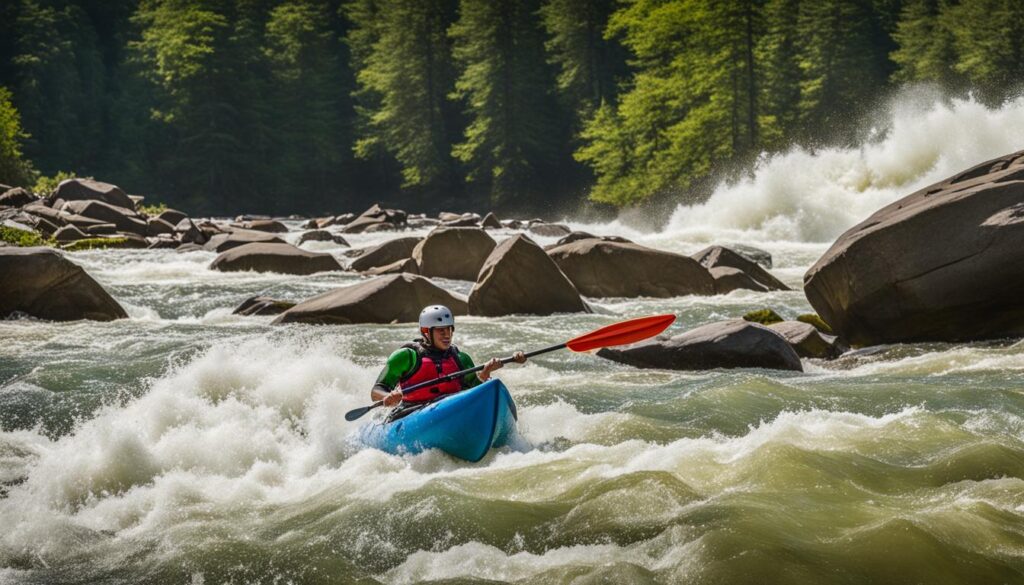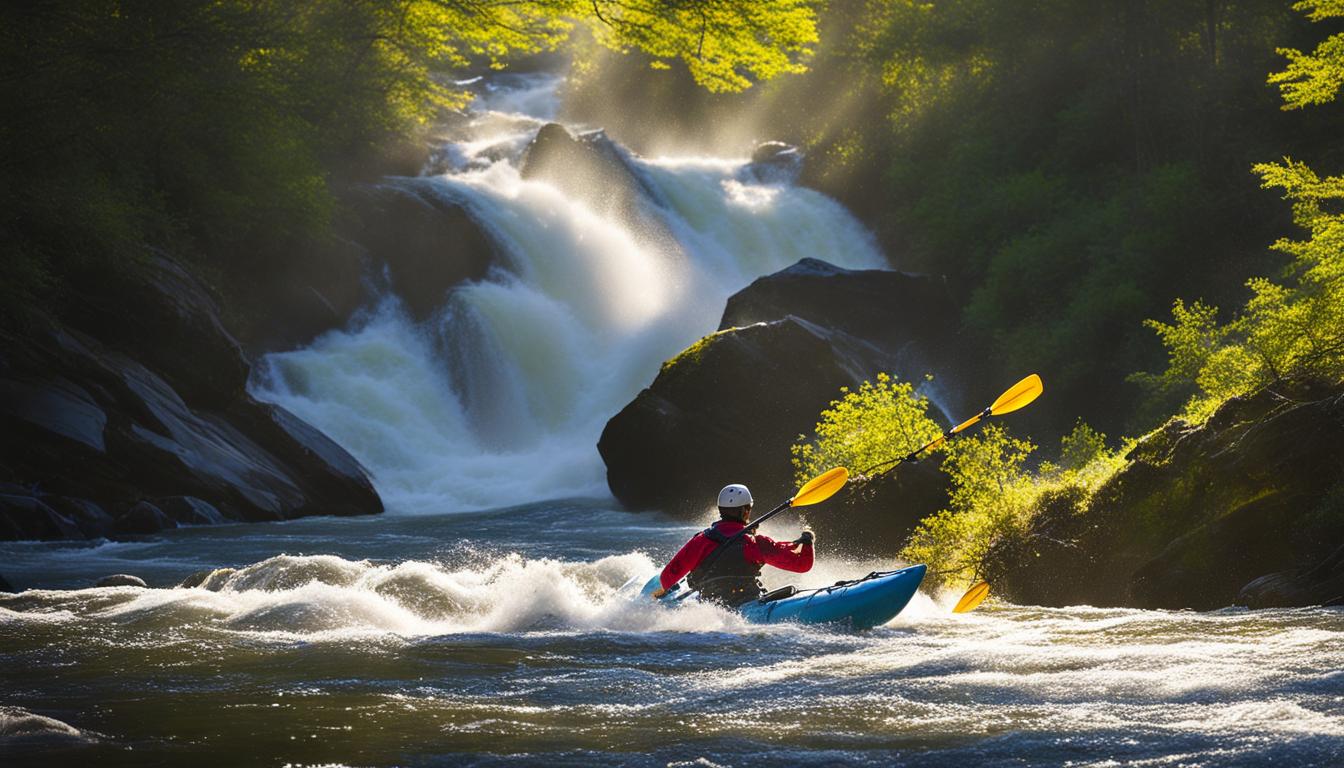Welcome to River Rapids Navigation: A Kayaker’s Guide. If you’re an adventure enthusiast seeking the thrill of navigating whitewater rapids, you’ve come to the right place. Whitewater kayaking offers a unique blend of adrenaline, serenity, and connection with nature. This guide will equip you with the skills and knowledge needed to conquer rapids and embark on an unforgettable kayaking experience.
Key Takeaways:
- Navigating whitewater rapids requires mastering essential skills and techniques
- Reading the river and understanding its flow patterns is crucial for safe navigation
- Proper safety precautions and gear are essential for an enjoyable kayaking experience
- Assessing the difficulty of rapids and choosing appropriate sections is important for beginners and experienced kayakers
- By continuously learning and practicing, you can enhance your rapid recognition skills and become a proficient kayaker
Essential Skills and Techniques for Navigating Rapids
Mastering the art of paddling is essential for navigating rapids. Understanding various paddle strokes, such as the forward stroke, reverse stroke, and sweep stroke, will allow you to maneuver through the water with power and efficiency. The forward stroke is the basic paddling stroke used for propulsion, while the reverse stroke helps you slow down or stop. The sweep stroke is used to turn the kayak and change direction. These strokes, when practiced and executed correctly, enable you to navigate rapids more effectively.
Another crucial skill for navigating rapids is learning the Eskimo roll. This technique allows you to recover from a capsize without exiting the kayak. By using a combination of body movements and paddle placement, you can roll the kayak upright and regain control. The Eskimo roll is a valuable skill to have, as it boosts your confidence and enables you to continue paddling even in challenging situations.
Reading the river is a vital skill that allows you to understand the behavior of the water and choose the best path through the rapids. It involves observing patterns on the water’s surface, identifying currents and eddies, and avoiding obstacles such as rocks and strainers. By analyzing the flow of the river and recognizing its features, you can make informed decisions about which route to take. Assessing the difficulty of a rapid is essential, as it helps you gauge whether your skill level matches the challenge. It’s important to remember that not all rapids are the same, and understanding their characteristics will guide you in navigating them safely and skillfully.
| Rapid Navigation Techniques | Assessing River Rapid Difficulty | Techniques for Swift Water Navigation |
|---|---|---|
| Master paddle strokes: forward, reverse, and sweep strokes | Observe patterns on the water’s surface | Learn the Eskimo roll for recovery |
| Practice the Eskimo roll for capsize recovery | Identify currents and eddies | Understand river flow and features |
| Read the river to choose the best path | Avoid obstacles such as rocks and strainers | Assess the difficulty of a rapid |
Safety Precautions and Preparation
When embarking on a whitewater kayaking adventure, it is essential to prioritize safety and adequately prepare yourself for the challenges that lie ahead. By taking the necessary precautions and ensuring you have the right gear, you can minimize risks and enhance your overall kayaking experience.
Essential Gear for Whitewater Kayaking
Investing in the right gear is crucial to ensure your safety while navigating through rapids. Here are some essential items every whitewater kayaker should have:
- A well-fitted helmet: Protects your head from potential impact with rocks or other obstacles in the river.
- A personal flotation device (PFD): Also known as a life jacket, it provides buoyancy and keeps you afloat in case of an unexpected swim.
- Closed-toe footwear with good traction: Protects your feet from sharp rocks, debris, and provides stability while maneuvering your kayak.
- A spray skirt: Covers the opening of your kayak cockpit, preventing water from entering and keeping you dry.
- Appropriate clothing: Wear quick-drying clothes suitable for the weather conditions, and consider a wetsuit or drysuit for colder waters.
River Classifications for Kayakers
Understanding river classifications is crucial for determining the difficulty level of a particular section and selecting the appropriate route for your skill level. The International Scale of River Difficulty, developed by the American Whitewater Association, categorizes rivers into six classes:
| Class | Description |
|---|---|
| Class I | Easy, moving water with few or no obstacles. Ideal for beginners. |
| Class II | Straightforward rapids with some obstacles and small waves. Suitable for novice paddlers. |
| Class III | Intermediate rapids with moderate waves, stronger currents, and more complex maneuvers required. |
| Class IV | Advanced rapids with powerful waves, turbulent water, and precise maneuvering required. |
| Class V | Expert-level rapids with extremely difficult obstacles, large drops, and highly technical maneuvers. |
| Class VI | Unrunnable or extremely dangerous rapids. Reserved for experienced professionals. |
It is essential to assess your skills honestly and choose rivers within your capabilities. Starting with easier classes and gradually progressing will allow you to build confidence and improve your paddling abilities.
Aside from proper gear and river classifications, additional safety precautions include kayaking with a group or experienced paddlers, informing someone of your plans and expected return time, and considering taking whitewater rescue courses to learn essential rescue techniques.
By following these safety guidelines and adequately preparing yourself, you can embark on your whitewater kayaking adventure with confidence, knowing that you are equipped to handle the challenges that come your way.
Learning to Read River Rapids
Reading the river is a fundamental skill for navigating rapids. It allows you to understand the language of the river and interpret its cues, enabling you to choose the best path through the rapids. By observing patterns on the water’s surface, such as ripples and waves, you can gauge the level of turbulence in the water. This information is crucial for making decisions on how to navigate the rapid effectively. Additionally, recognizing currents and the “V” pattern on the water can guide you towards the smoother path through the rapids.
Eddies are another important feature to look out for when reading the river. These calm spots in the water are formed when the current is deflected by an obstacle, such as a rock. Eddies provide an opportunity to rest, regroup, or change directions. They are often found just downstream of rocks or other obstructions in the water. Identifying and utilizing eddies can help you strategize your approach to the rapids.
“Reading the river is like understanding the subtle language of nature. It’s about learning to anticipate the river’s movements and using that knowledge to navigate with confidence and finesse.”
On the other hand, it’s crucial to be aware of potential obstacles in the rapids, such as rocks and strainers. Rocks can create hazardous conditions and cause capsizes or injuries if not avoided. Strainers are objects like fallen trees or branches that can trap and entangle you in the current. These obstacles should be recognized and avoided to ensure a safe and successful journey through the rapids.
| Feature | Description |
|---|---|
| Ripples and waves | Indicate the level of turbulence in the water |
| Currents and “V” pattern | Guide towards the smoother path through the rapids |
| Eddies | Provide calm spots for resting or regrouping |
| Rocks and strainers | Obstacles to be avoided for safety |

The ability to read river rapids comes with experience and practice. As you spend more time on the water, you’ll develop a better understanding of the river’s behavior and be able to anticipate its movements. Remember to always prioritize safety and make informed decisions based on your skill level and the conditions of the rapids. By honing your river reading skills, you’ll be able to navigate rapids with confidence and enjoy the thrilling experience of whitewater kayaking.
Conclusion
Navigating whitewater rapids is an exhilarating and challenging adventure that requires the right strategies and techniques. By mastering essential paddling skills and understanding how to navigate river currents, you can confidently conquer rapids and enjoy the thrill of the water.
Remember to prioritize safety by wearing proper gear, including a well-fitted helmet and a personal flotation device (PFD). Paddling with a group can also enhance safety and provide support during challenging sections of the river. Always be aware of your skill level and choose river sections that match your experience.
Continuing to learn and grow as a kayaker is essential for navigating rapids effectively. Consider taking courses or seeking guidance from experienced paddlers to enhance your skills. By staying knowledgeable, prepared, and focused, you will be able to navigate rapids with confidence and make the most of your whitewater kayaking adventures.
FAQ
What skills are essential for navigating rapids?
Essential skills for navigating rapids include mastering various paddle strokes, learning the Eskimo roll, and being able to read the river.
What gear should I have for whitewater kayaking?
It is important to have a well-fitted helmet, a personal flotation device (PFD), and closed-toe footwear with good traction. This gear will ensure your safety on the water.
How do I assess the difficulty of a rapid?
River classifications are used to assess the difficulty of a rapid. Beginners should start with Class I and II rivers, while experienced kayakers can venture into higher classes.
Is it safe to kayak alone?
It is recommended to kayak with a group for added safety. This way, you can have assistance if needed and enjoy the company of fellow paddlers.
How can I recognize features in rapids?
Observing patterns on the water’s surface, such as ripples and waves, can indicate the level of turbulence. Currents and the “V” pattern on the water can guide you towards a smoother path through the rapids.





